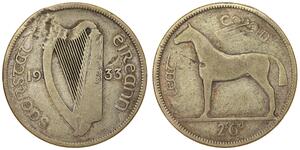(продана за $144.0)
1857, Sweden, Charles XV. Silver Riksdaler Riksmynt Coin. Rare 1-Year Type!
Mint year: 1857
Mint Place: Stockholm
Designer: Lea Ahlborn
References: KM-693. RR!
Mint Official: Sebastian Tham
Condition: Uneven toning, otherwise a nice XF-AU!
Denomination: Riksdaler Specie (4 Riksdaler Riksmynt)
Material: Silver (.750)
Diameter: 25mm
Weight: 8.42gm
Obverse: Head of Charles XV as King of Norway and Sweden right. Designer's signature (LA - Lea Ahlborn) below bust.
Legend: CARL XV SVERIGES NORR. GÖTH. OCH VEND. KONUNG.
Reverse: Crowned shield with arms of Sweden/Norway, supported by crowned roaring lions, standing on decorative frame.
Legend: RÄTT OCH SANNING - 1 RD. RIKSM. / S. 1857 T.
Lea Fredrika Ahlborn (née Lundgren) (18 February 1826 – 13 November 1897) was a famous Swedish artist. She was a member of the Royal Swedish Academy of Arts, and the first woman to be appointed royal printmaker. The position of royal printmaker was public office, and thereby also made her the first female official in Sweden.
As the child of printmaker Ludvig Lundgren, Lea Ahlborn early decided to follow him in his profession. In 1849, she, as well as Amalia Lindegren and Agnes Börjesson, became one of the four women who were given permission to study art at the Royal Swedish Academy of Arts.
In 1851, she made a study-trip to Paris with her teacher Carl Gustaf Qvarnström (1810–1867) and her brother Pehr Henrik, where she worked with the sculptor Toussaint, the printmaker Barre and her maternal uncle, the medal designer Johan Salmson.
In 1853, she returned to Sweden; the same yer, her father died, and she functioned as royal printmaker until the return of her brother, who was decided to take over their fathers position, but her brother died in Paris. In 1855, she was appointed royal printmaker and elected as a member in the Royal Swedish Academy of Arts. She kept herself updated in everything regarding her work, and was given assignments from the Swedish Academy, the Royal Swedish Academy of Sciences and the royal academy Pro Patriaa and by Empress Eugenie of France. She made the medal-portraits to the celebration of the anniversary of the wedding of the king and queen, and she was hired by the United States government to make the medal of George Washington at the centenary (hundred years anniversary) of the end of the war of independence in 1883, and to the celebration of Christopher Columbus' discovery of America in 1892. In 1892, she was given the medal Illis Quorum by king Oscar II of Sweden.
Her sister, Carolina Weidenhayn, (1822–1902), became the first professional female xylographer, who after studies in Paris 1858–1867, became an instructor (1859–1881) at the technical school Tekniska Skolan (now Konstfack or University College of Arts, Crafts and Design) in Stockholm, Sweden. Lea Ahlborn married the artist Carl Ahlborn and had several children.
Charles XV & IV also Carl (Carl Ludvig Eugen); Swedish and Norwegian: Karl (3 May 1826 – 18 September 1872) was King of Sweden (Charles XV) and Norway (Charles IV) from 1859 until his death.
Though known as King Charles XV in Sweden, he was actually the ninth Swedish king by that name, as his predecessor Charles IX (reigned 1604–1611) had adopted a numeral according to a fictitious history of Sweden.
He was born in Stockholm Palace, Stockholm, and dubbed Duke of Skåne at birth. He was the eldest son of King Oscar I and Josephine of Leuchtenberg. He was given his first officer's commission in 1841 by his grandfather, Charles XIV John. After his father's accession to the throne in 1844, he was made a chancellor of the universities of Uppsala and Lund, and in 1853 chancellor of Royal Swedish Academy of Arts. On February 11, 1846, he was made an honorary member of the Royal Swedish Academy of Sciences.
The Crown Prince was Viceroy of Norway briefly in 1856 and 1857. He became Regent on 25 September 1857, and king on the death of his father on 8 July 1859. As grandson of Augusta of Bavaria, he was a descendant of Gustav I of Sweden and Charles IX of Sweden, whose blood returned to the throne after being lost in 1818 when Charles XIII of Sweden died.
On 19 June 1850 he married in Stockholm Louise of the Netherlands, niece of William II of the Netherlands through her father and niece of William I of Prussia, German Emperor, through her mother. The couple were personally quite dissimilar; Princess Louise was in love with her husband, whereas he preferred other women. His well-known mistresses included the countess Josephine Sparre, Wilhelmine Schröder and the actresses Hanna Styrell and Elise Hwasser, the latter the most celebrated actress in Sweden during his reign, and the Crown Prince neglected his shy wife. On the other hand, his relationship to his only daughter, Louise, was warm and close.
As Crown Prince, Charles' brusque manner led many to regard his future accession with some apprehension, yet he proved to be one of the most popular of Scandinavian kings and a constitutional ruler in the best sense of the word. His reign was remarkable for its manifold and far-reaching reforms. Sweden's existing communal law (1862), ecclesiastical law (1863) and criminal law (1864) were enacted appropriately enough under the direction of a king whose motto was: Land skall med lag byggas - "With law shall the land be built". Charles also helped Louis De Geer to carry through his memorable reform of the Parliament of Sweden in 1866. He also declared the freedom of women by passing the law of legal majority for unmarried women in 1858 - his sister Princess Eugenie became the first woman who was declared mature.
Charles was an advocate of Scandinavianism and the political solidarity of the three northern kingdoms, and his friendship with Frederick VII of Denmark, it is said, led him to give half promises of help to Denmark on the eve of the war of 1864, which, in the circumstances, were perhaps misleading and unjustifiable. In view, however, of the unpreparedness of the Swedish army and the difficulties of the situation, Charles was forced to observe a strict neutrality. He died in Malmö on 18 September 1872.
Charles XV attained some eminence as a painter and as a poet. He was followed on both the thrones of Norway and Sweden by his brother Oscar II.
In 1855 he became the 990th Knight of the Order of the Golden Fleece in Spain.
A few weeks before Charles' death, his daughter Louise (then the Crown Princess of Denmark) gave birth to her second son. The young Prince of Denmark became christened as grandfather Charles' namesake. In 1905 this grandson, Prince Carl of Denmark, ascended the throne of Norway, becoming thus his maternal grandfather's successor in that country, and assumed the reign name Haakon VII. The present king, Harald V of Norway, is Charles' great-great-grandson, through his father and mother.
No subsequent king of Sweden to this day is Charles' descendant. However, his descendants are or have been on the thrones of Denmark, Luxembourg, Greece, Belgium and Norway.
Only 1$ shipping for each additional coin purchased!

|
Добавив:
anonymous 2015-09-06 |
50 Франк Бельгія Срібло
в групі 3 монет / 3 цін
⇑
1/2 Крона(англійська) Ірландія (1922 - )
в групі 44 монет / 43 цін
⇑

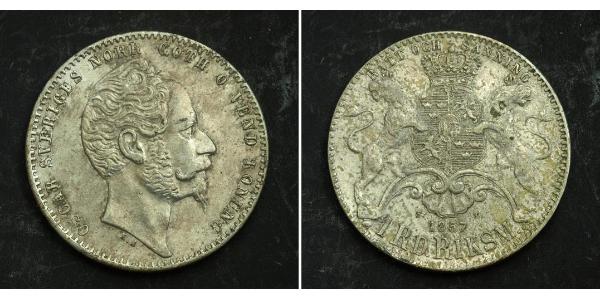




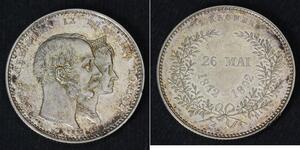
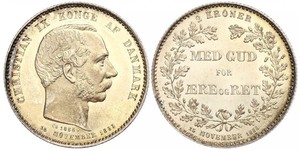


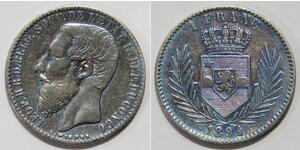
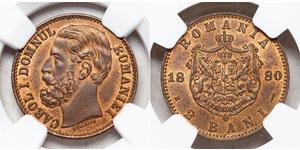
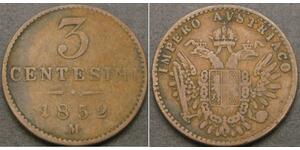

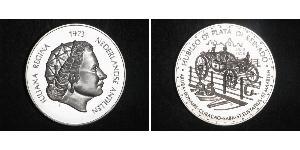
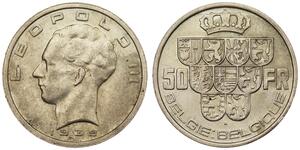
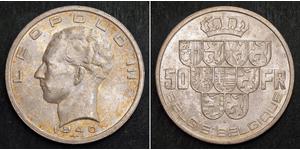
-a-Ірландія_(1922_)-300-150-cqgKbzbiQeMAAAFLYpCjltiK.jpg)
